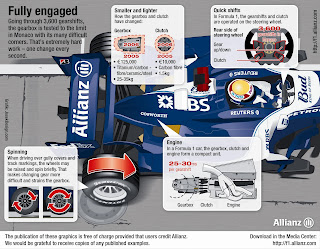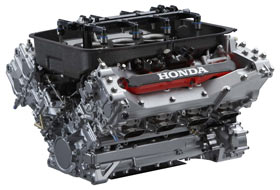 To figure out where the line is and why, we must first understand what happens in a corner. In a race car, we strive to be using all of the car and its tires at all times. This means we are always accelerating at full throttle when possible, and we're always braking as hard as possible. As we've talked about, tires grip both longitudinally and laterally. These grip levels are not independent of each other; if you are using all of the tires' grip to brake, you won't be able to turn. This is very easy to try for yourself in an empty lot.
To figure out where the line is and why, we must first understand what happens in a corner. In a race car, we strive to be using all of the car and its tires at all times. This means we are always accelerating at full throttle when possible, and we're always braking as hard as possible. As we've talked about, tires grip both longitudinally and laterally. These grip levels are not independent of each other; if you are using all of the tires' grip to brake, you won't be able to turn. This is very easy to try for yourself in an empty lot.We can better visualize this idea of available grip with the 'traction circle'. The basic idea is that at any time the tire has 100% of its grip to be allocated to turning, braking, and accelerating. So you can turn and brake at the same time, but only in a combination that doesn't exceed 100%, say 60% braking/40% turning.
 Let's pretend we are in our race car headed for a 90 degree left turn. We'll stay 100% on the throttle until we get to our 'braking point'. The braking point is some point before the corner when 100% braking should start. This point is far enough ahead of the corner that the car will slow down enough to make the corner.
Let's pretend we are in our race car headed for a 90 degree left turn. We'll stay 100% on the throttle until we get to our 'braking point'. The braking point is some point before the corner when 100% braking should start. This point is far enough ahead of the corner that the car will slow down enough to make the corner.Usually the best line through the corner is the one with the widest possible radius. This means that coming into the corner, we want to place the car on the right side of the track; outside for a left-hand turn. After we finish braking, we reach the 'turn-in' point, the point at which we begin to steer the car to the left. We'll aim the car at the left side of the track at the innermost point of the corner. This is the 'apex'. From the apex, we slowly unwind the steering wheel and begin to squeeze the accelerator. We aim the car at the right (outside) edge of the corner.
 So the pattern for a simple corner is outside-inside-outside. The car lines up as far as possible away from the corner (outside), drives an arc that clips the apex (inside), and then tracks out to the edge of the track (outside).
So the pattern for a simple corner is outside-inside-outside. The car lines up as far as possible away from the corner (outside), drives an arc that clips the apex (inside), and then tracks out to the edge of the track (outside).Now things are not quite that simple. There are various positions of apexes, described as early or late. An early apex means turning the car and continuing to brake into the corner, than adding more steering at the apex. A late apex means keeping the car outside longer, then adding steering to get to the apex, then reducing steering and accelerating. Basically, an early apex is faster into the turn, a late apex is faster out of the turn. So which one is right? Well it depends on the track. If there is a long straight after the turn, a late apex will be faster. But if there is a long straight before the turn, and another turn immediately after, an early apex line may be faster. Generally speaking, the ideal line is a late apex line.
 Here's another view of the various lines. The green line represents a 'neutral' apex line; the line that would be the fastest through the turn, ignoring the straight parts of the track before and after. The dark blue line represents the early apex line. You can see by pointing the car towards the apex, the early apex line begins with the car traveling straight towards the apex. During this time the early apex driver can brake, but the early apex line then must turn tighter after the apex to stay on track. The light blue line represents the late apex. With this line, the driver does all the braking before turning in. The late apex line has to do more turning before the apex, but then gets a straight shot to accelerate after the apex. Thus the common racing adage for late-apexing: "slow in, fast out".
Here's another view of the various lines. The green line represents a 'neutral' apex line; the line that would be the fastest through the turn, ignoring the straight parts of the track before and after. The dark blue line represents the early apex line. You can see by pointing the car towards the apex, the early apex line begins with the car traveling straight towards the apex. During this time the early apex driver can brake, but the early apex line then must turn tighter after the apex to stay on track. The light blue line represents the late apex. With this line, the driver does all the braking before turning in. The late apex line has to do more turning before the apex, but then gets a straight shot to accelerate after the apex. Thus the common racing adage for late-apexing: "slow in, fast out". Things get even more complicated when we consider a series of corners, not just one turn in isolation. Often there may be 3 or 4 turns strung together which requires a 'compromise' line; a line that may not be ideal in each turn, but overall results in the best speed.
Things get even more complicated when we consider a series of corners, not just one turn in isolation. Often there may be 3 or 4 turns strung together which requires a 'compromise' line; a line that may not be ideal in each turn, but overall results in the best speed. Racers have come up with some general terms to describe types of corners. First is the 'sweeper'; a long, flowing high-speed turn, similar to a long circular off-ramp. An 'S' or 'Esses' is a combination of alternating turns in an 'S' shape, as you might expect. A 'hairpin' is a turn that is usually about 180 degrees and quite slow, usually with a straight leading in and another leading out. Finally, a 'chicane' (pronounced "sha-kane") is a tight left-right or right-left combination, usually at the end or middle of a straight. Often, chicanes are added to tracks to slow the cars down. Often times a chicane will have cones or soft barriers marking the edges of the track to minimize risk to a driver who enters the turn too fast. If a driver does miss the chicane, they can drive back onto the track, but they cannot gain any positions. The Ferrari at right is entering a chicane. The two cones mark the apexes of the turns.
Racers have come up with some general terms to describe types of corners. First is the 'sweeper'; a long, flowing high-speed turn, similar to a long circular off-ramp. An 'S' or 'Esses' is a combination of alternating turns in an 'S' shape, as you might expect. A 'hairpin' is a turn that is usually about 180 degrees and quite slow, usually with a straight leading in and another leading out. Finally, a 'chicane' (pronounced "sha-kane") is a tight left-right or right-left combination, usually at the end or middle of a straight. Often, chicanes are added to tracks to slow the cars down. Often times a chicane will have cones or soft barriers marking the edges of the track to minimize risk to a driver who enters the turn too fast. If a driver does miss the chicane, they can drive back onto the track, but they cannot gain any positions. The Ferrari at right is entering a chicane. The two cones mark the apexes of the turns.Now maybe you can see why the drivers get paid so much. Finding the line and hitting it consistently lap after lap, with the car on its limits of grip is quite difficult, and even more-so in the pinnacle of cornering which is the F1 car.












































